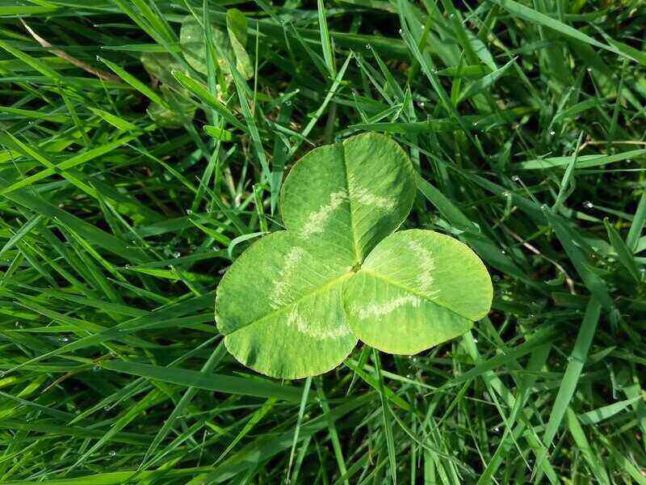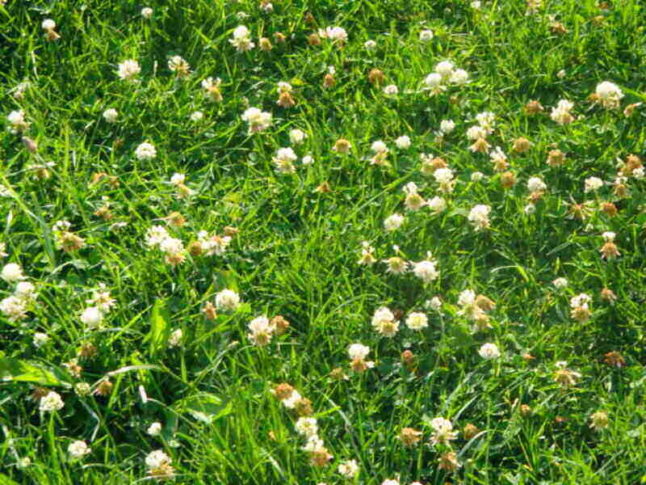
Have you heard of clover lawns? If you’re like many homeowners, you’re looking to save water, time, and money on your landscaping. A clover lawn could be your solution. We’ll explain the top eight reasons to plant a clover lawn.
Here are the 8 Reasons to Plant a Clover Lawn
1. Clovers Fertilize Your Lawn
If you’re tired of spending loads of cash on nitrogen for your lawn, let clover do the job for you. According to Melissa Sharapova, a permaculture and landscaping expert, “Clovers are a beneficial addition to turfgrass because they fix atmospheric nitrogen into [the] soil [and] eliminate the need for synthetic fertilizer.
There are also ecological benefits to reducing your synthetic fertilizer use. A 25 years veteran in the horticultural industry, Sharapova adds that less fertilizer use “reduces nutrient runoff into local streams and aquatic habitat.”
2. Clovers Reduce Disease Risk
Lawn diseases are awful, but clovers could be your answer. “Clover …draws up and accumulates trace minerals. When clover decomposes, it makes the minerals available to the lawn grass and soil life. The grass becomes more disease resistant because of the health benefits of clover,” Sharapova notes.
In effect, making friends — not enemies — with clover means you’ll need less fertilizer, herbicide, and chemicals to keep disease at bay. This could save you a pretty penny, and it also makes clover better for the environment than grass-only lawns.
3. Clovers Reduce Weeds
It turns out clover does some of the “weeding” for you, too. As a dense ground cover plant, clovers — though they are also broad-leaved — are exceptional at crowding out other broadleaf plants such as dandelions, violets, and other plants that commonly populate lawns.
“Clover … crowds out broadleaf weeds because it quickly forms clumps that spread by secondary roots, or stolons,” says Sharapova.
In agriculture and gardening, clovers are common and successful cover crops. The University of Minnesota says, “Cover crops form a living mulch in gardens because they grow thickly among each other. They help reduce soil splash and erosion, and keep weeds in check.”
When sown in between major crop plantings, they keep weeds down on farm fields for the upcoming year. These quick spreaders cut down on herbicide use and costs, too.
4. Grass and Clovers are Mutually Beneficial
Clovers are kind to grasses and considered companion plants. Even today, you’ll see many lawns and fields where clovers and grass coexist peacefully, side-by-side.
Jeff Lowenfels, veteran Anchorage Daily News gardening columnist, notes that clover was considered so essential for lawns back in the day that it was a standard, even necessary, component in lawn seed mixes. Says Lowenfels, “You couldn’t find a lawn seed mix without it!”
Grasses even return some favors to clovers, especially when it comes to a lush and beautiful lawn. Says Sharapova, “White clover can withstand foot traffic, but will do so better mixed with grass.”

5. Clovers are Drought Tolerant
While establishing clovers, they will need near daily waterings (like grass), but once they have taken hold, they require little watering upkeep.
Clover roots reach deep into the soil to draw up the water they need, which saves time and money. Clover also stays greener longer in times of drought.
Music to many lawn lovers’ ears: “Clover will stay green all summer long.”
6. Clovers are Pollinator Friendly
Clover flowers attract pollinators like honey bees. Especially with many pollinators losing their habitats, having a clover lawn can be a safe haven for them. Having honey bees around is good for your garden, honey production, and the environment. Just be careful to avoid bee stings and wasps.
Want an added bonus? Many pollinators are natural pest control, saving you even more hassle and money.
7. Clover Lawns Save Time and Money
Let’s recap the time and money-saving benefits we’ve seen so far. Clover lawns are:
- Low-maintenance
- Require less fertilization
- Less risk of disease
- Less watering
- Less pest control
- Less weeding
But wait, there’s more!
Clover lawns need less mowing and less aeration, too.
- Clover lawns will only need to be trimmed a few times during the growing season, unlike the weekly mows of a grass lawn.
- Clover roots are like a living mulch and naturally keep soil from compacting. Their deep decomposing roots also attract earthworms whose movement keeps the soil loose.
Are you thinking about checking clover out? Well, great news. Clover seeds are way cheaper than grass seeds — about $1 per 1,000 square feet.
8. Clover Increases Erosion Control
As we’ve talked about, clover roots go deep. These deep roots help keep the clovers, soil, and nutrients in place through weather challenges.
Clover roots also prevent soil compaction due to their excellent natural aeration ability. How does this help with erosion control? Compacted soil leads to run-off and erosion. Because clover lawns increase aeration, they also reduce erosion.

A History of Clover Lawns
So with the many benefits of having a clover garden, why don’t most homes have them? Here’s the short answer: It was branded a weed.
A Useful Past and Fun Facts
- Clovers — specifically Trifolium repens — have for centuries been domesticated ground cover plants or livestock forage plants.
- Clover is a legume, in the same plant family as peas, beans, and peanuts.
- While it is native to the Mediterranean, it was introduced into the United States early in the colonial days.
- By 1747, it was common enough that Benjamin Franklin noted red clover’s value in improving pastures.
- Today, it grows readily from Canada to Texas, from Florida to Alaska.
A Weedy Present
But what happened along the way to transform clover from valiant lawn companion to enemy of the suburbs, deserving removal of root and stem?
About 60 years ago, a war began on broadleaf plants. The ones who waged it: gardening and agricultural herbicide companies, the very same who create herbicides we use today.
These weed killers tend not to affect grasses — but they kill everything else, clovers included.
Sharapova says, “Prior to World War II, lawn grass seed mixes actually contained clover seed. [But] by the 1950s, with aggressive marketing by chemical companies of synthetic herbicides … clover became identified as a weed.”
A Well Rooted Future
It’s not too late to dump the chemicals and reintroduce a springy, soft, green carpet of clover back into your lawn. It’s cushy to the feet and aids in both weed control and erosion control.
How to Plant a Clover Lawn
Are you a homeowner ready to plant a clover lawn? Excellent.
Follow these steps to plant clover in existing lawns:
- Prepare your lawn: Set your mower to a lower setting and cut your grass shorter than normal (but not too short!) to allow clover seeds to reach the soil. If needed, remove any thatch that has built up, or aerate the lawn if you have compacted soil. Sharapova says, “It is best to sow clover early in the season (late March-April).”
- Spread the seeds: Spread the seeds throughout your lawn. Full sun areas are where clover plants thrive. For optimal results, overseeding is best.
- Water daily: Water clover seeds daily during the establishment – about 7-10 days. This may already be part of your lawn care routine, depending on area rainfall.
- First cut: Wait until the clover seeds drop, then cut it at about 2 inches.
- Maintain: After your first cut, the clover is established. Cut a few times through the growing season for appearances, and water as needed.
Now that you’ve overseeded with clover, check out our article on how to maintain your lawn in “Lawn Care for Beginners (in 13 Easy Steps).”
FAQ About Clover Lawns
The most common is white clover. And among white clovers, the most common is the Dutch white clover. White clover can be found throughout vineyards and orchards and produces pink and white flowers.
However, with over 10 common clover types throughout the United States, there is no definitive answer to what is the best type. It depends on the climate that you live in.
Clover lawns last about one to three years — not quite as long as turfgrass. So, when should you reseed?
• Bare spots: If you’re seeing bare or brown areas, reseed the bare spots.
• Bare lawn: If you’re seeing 50 percent of your lawn not returning, it’s time to reseed your whole lawn.
• Seed well: Because not all clover seeds sprout right away, lean toward the high side of the manufacturer’s seeding recommendations. For example, the University of Minnesota recommends spreading white clover at a rate of 0.25 – 1 pound of seed per 1,000 square feet.
Remember that reseeding practices will vary depending on a variety of factors, including:
• Clover type
• Climate
• Soil type
• Foot traffic
• If it’s allowed to reseed itself
Clovers are great for a green lawn. They are one of the first plants to reemerge in the early spring and go dormant when the first frost comes in the fall (or later in some areas).
They also stay greener than most plants in times of drought. Be careful not to use herbicides and weed killers, though, as many will cause damage to your clover plants.
Micro clover plants are a smaller version of the white clover. They have smaller leaves, fewer flowers, and blend in with grasses better than some other clover types. Micro clover disadvantages include being less heat and drought-tolerant than other clover types.
Hire a Lawn Care Pro to Plant a Clover Lawn
Want to give clover lawn a try? Or maybe you’re not quite ready for a change. The great part of owning your lawn, it’s yours to care for and try new things whenever you’re ready. But it’s also time-consuming. Sometimes we want to relax on our time off, not attend to lawn care maintenance.
Local landscape professionals will take on that workload so you can enjoy your lawn stress-free. Local, experienced, highly rated pros are available to give you the lawn you want at a price you’re happy with. A free, fast, and easy quote is just a click or call away.
* LawnStarter participates in the Amazon Services LLC Associates Program, an affiliate advertising program. LawnStarter may earn revenue from products promoted in this article.
Main photo credit: NY State IPM Program at Cornell University / Flickr / CC BY 2.0